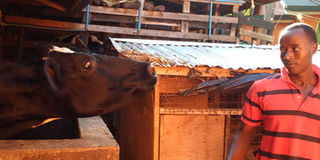Dairy farming in your home backyard

A farmer approaches as a cow readies for milking. File photo
What you need to know:
Dr Jolly Kabirizi advises dairy farmers to embrace best farm practices to make money from milk, writes Desire Mbabaali
Utilising the little resources one has is a paramount principle in life, especially if you plan farming in urban areas where land is usually limited.
Dr Jolly Kabirizi, who holds a PhD in animal science, and is a farmer shares how she has done that at her home in Sseguku, Entebbe Road.
In her backyard (less than an acre) she established a small farm – Kyakuwa farm, which she says is a model farm for peri-urban farmers who want to do small scale production but on commercial basis.
This small space holds 10 animals, among other farming activities.
The beginning
Inspired by the need to ‘practice what she preaches’, Dr Kabirizi started farming. “This was long ago in 1990. My start was with the heifer women projects, where women were given cows on loan. They would give you a cow on arrangement that you return the first female heifer. But that beginning was not easy, because that cow was killed but I never gave up.”
She managed to get another cow, which was also almost killed but then she found the source of the problem - (the person killing them was not far from where she lived) “So, gradually, I went on adding more cows, as the others also give birth(calved). Currently, I have 10 cross breeds on the farm, three of them lactating,” she says.
Best practices
“This is how I would put it, monitoring, participation and management. If you are a farmer who only sits down and thinks your employees will do everything for you, then you are in for a loss. You really have to participate and monitor how things are being done – day in and out,” Dr Kabirizi advises.
Maintaining cleanliness is crucial to avoid flies.
Thus the way you dispose of your manure matters a lot. “Here, we have a pit, which is well covered where we dispose it off. Every after two weeks, we remove the manure from the pit and either use it on plants or sell it to other farmers,” she says.
Feeding
Most farmers find great challenges in feeding their animals, Dr Kabirizi says, when it comes to feeding, pastures are the main feeds the farmers including herself use. The pasture includes foliage such as elephant grass are planted to feed the cattle.
But in a place like this where land is a limiting factor, we depend mainly on purchased food, like banana peelings and dairy pellets. But if you want your animal’s milk to be of good quality, calliandra tree is the way to go. I even planted it here because it is the best supplement.”
“We have those drums (pointing at the numerous plastic drums in a corner). We use a lot of silage especially for dry seasons. What we do is buy sweet potato vines – and you can keep them in drums, you can keep them for about three years as long as it is air tight,” she continues.
When the cow is on heat, Kabirizi uses artificial insemination to fertilise the ovary.
Milk production
“The kind of breed one is keeping determines the quality and quantity of milk production. For example, if you are keeping local breeds, it will give you one to three litres per day. I keep cross breeds which are more resistant but also have a relatively high milk production and with good quality, (butter fat content), she notes. The other factors she lists are; good housing, disease control, as these affect both milk quantity and quality and the feeding itself. “If you don’t feed the cattle very well, you don’t expect it to give you much milk – with a good quality,” Dr. Kabirizi mentions. But also the number of times the animal has calved matters. “For cows calving for the first time, milk quantity is normally low, but it gradually increases on the second and proceeding times,” she says.
She is able to get between 15-32 liters per day, per cow, depending on a number of issues like; feeding and the weather. For profitable livestock farming it means that one should have a calf every year, otherwise it becomes unprofitable.
Milk etiquette
“Cleanliness is paramount. Avoid putting milk in plastic containers, but instead use metallic cans. Before milking, the place you are using must be clean, to avoid the dung and other dirt going into the milk, which affects its quality and makes it unhealthy,” she advises.
Milk market
Dr Kabirizi says, “For the time being, I am not adding value but we have enough customers to pay for the milk, some of whom I have had over the last 10 years, because they have established that trust in the quality of our milk – we add no water, and most of these are mothers. I have a milk shop just outside here – with a fridge, and a person ready to sell the milk to the customers. A litre ranges between Shs1, 800-Shs2, 000 depending on the season. There are times milk is in plenty – usually in the rainy season, and times when production is low, so the prices change accordingly.”




